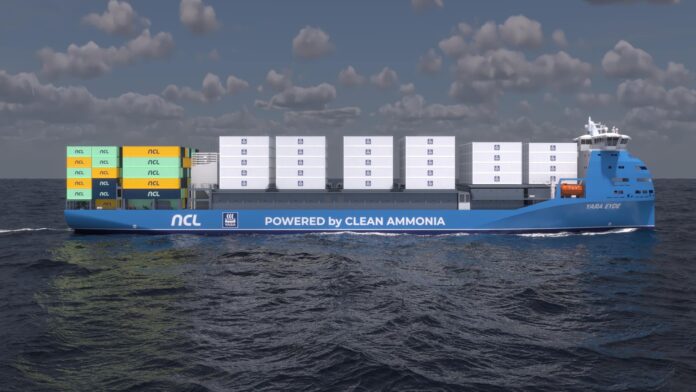Norwegian regional operator North Sea Container Lines (NCL), which already ordered an ammonia powered vessel at the end of last year, has ordered a ground-breaking ship that uses new ammonia-cracking technology to power its latest newbuilding.
The company has ordered a 300 TEU vessel which will be powered by a hydrogen fuel cell, with the gas derived from an Amogy designed ammonia cracker that uses a catalyst to separate ammonia into nitrogen and hydrogen on board the vessel.
The Amogy system will be deployed on the vessel, housed in two 20ft containers, each with two 200kW powerpacks, totalling 800kW in total and the boxes will include ventilation and state of the art safety systems, according to the New York based technology company Amogy.
Seonghoon Woo, CEO at Amogy told Container News that the key ingredient in the catalyst is ruthenium, a rare metal, which the Royal Society of Chemistry says is found in South Africa, Russia and Zimbabwe.
“We are starting small but the technology can be scaled up to much larger, deepsea, ships,” said Woo.
Container News understands that the vessel is scheduled to be delivered in 2026.
Bente Hetland, CEO of NCL, said: “The Amogy ammonia-powered system meets these criteria in our latest project for very small container feeders,” adding, “This unique partnership with Amogy will allow us to demonstrate it is possible to provide world-class service and cut emissions at the same time.”
However, Hetland refused to respond to further questions on the vessel’s development, which will see the dispersal of nitrogen into the atmosphere.
According to the UN Environment Programme (UNEP)’s 2018-2019 Frontiers Report, “nitrogen costs the global economy between US$340 billion and US$3.4 trillion annually when taking into account its impact on human health and ecosystems.”
UNEP warns of the dangers caused by nitrogen, mainly from agricultural use of fertilisers, but also from gas emissions, alerting readers to the fact that the gas is 300 times more potent as a GHG than carbon dioxide, while remaining active in the atmosphere for more than 100 years.
“Altogether, humans are producing a cocktail of reactive nitrogen that threatens health, climate and ecosystems, making nitrogen one of the most important pollution issues facing humanity,” said UNEP.
Nevertheless, Woo said: “Ammonia cracking splits ammonia into its base elements of hydrogen and nitrogen. The hydrogen is used to create electricity in the fuel cell, meanwhile the nitrogen is safely released into the atmosphere, which is already made up of about 78% nitrogen.”
The reference in the UNEP report is not Nitrogen in its pure N2 form, but nitrous oxide (N2O), which is a greenhouse gas and is about 300 times more powerful than CO2.
Nitrogen (N2) in its original form is the most abundant gas on Earth at about 78% of the air that humans breathe. The ammonia (NH3) that is fed into Amogy’s ammonia-cracking technology is produced from that abundant N2. Therefore, the N2 that Amogy releases from the system is not excess N2 and is completely harmless to the environment,” according to Amogy engineers.
The company also sought to differentiate its ammonia cracking technology from traditional ammonia combustion engines. “Unlike these engines, which emit significant quantities of NOx and N2O, our ammonia-cracking process primarily produces nitrogen (N2) and water as emissions. Any trace amounts of other harmful emissions remain significantly lower than industry standards and adhere strictly to the rules and regulations relevant to maintaining a safe product.”
Amazon, which considers decarbonising shipping as the biggest challenge, according to Woo, made a major investment into Amogy in 2021 and is listed as a partner for the company.
Announced in December 2021, Amazon refused to disclose the amount, which was thought to be in the region of $220 million, with the shipper backing Amogy through its $2 billion Climate Pledge Fund. The fund invests venture capital in companies that Amazon believes will help meet its goal of net-zero carbon emissions by 2040.
Mary Ann Evans
Correspondent at Large







